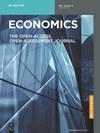The Great Recession Versus the Great Depression: Stylized Facts on Siblings that Were Given Different Foster Parents
IF 0.8
4区 经济学
Q3 ECONOMICS
Economics-The Open Access Open-Assessment E-Journal
Pub Date : 2010-01-01
DOI:10.5018/economics-ejournal.ja.2010-25
引用次数: 35
Abstract
This paper compares the depth of the Recent Crisis and the Great Depression. We use a new data set to compare the drop in activity in the industrialized countries for seven activity indicators. This is done under the assumption that the Recent Crisis leveled off in mid-2009 for production and will do so for unemployment in 2010. Our data indicate that the Recent Crisis indeed had the potential to be another Great Depression, as shown by the speed and simultaneity of the decline in the first nine months. However, if we assume that a large second dip can be avoided, the drop in all indicators overall will have been smaller than during the Great Depression. This holds true specifically for GDP, employment and priced, and least for manufacturing output. The difference in the depth in the crises concurs with differences in policy reaction. This time monetary policy and fiscal policy were applied courageously, speedily and partly internationally coordinated. During the Great Depression for several years fiscal policy tried to stabilize budgets instead of aggregate demand, and either monetary policy was not applied or was rather ineffective insofar as deflation turned lower nominal interest rates into higher real rates. Only future research will be able to prove the exact impact of economic policy, but the current tentative conclusion is that economic policy prevented the Recent Crisis from developing into a second Great Depression. This is also a partial vindication for economists. The majority of them might not have been able to predict the crisis, but it shows that the science did learn its lesson from the Great Depression and was able to give decent policy advice to at least limit the depth of the Recent Crisis.大衰退与大萧条:不同养父母的兄弟姐妹的程式化事实
本文比较了近期危机和大萧条的深度。我们使用一组新的数据来比较工业化国家在七个活动指标上的活动下降情况。这是在假定最近的危机在2009年年中就生产而言趋于平稳,而在2010年失业率也将趋于平稳的情况下进行的。我们的数据表明,最近的危机确实有可能成为另一场大萧条,正如前9个月衰退的速度和同时性所显示的那样。然而,如果我们假设可以避免第二次大幅下滑,那么所有指标的总体降幅将小于大萧条时期。这对GDP、就业和价格尤其适用,对制造业产出则不适用。危机深度的不同与政策反应的不同是一致的。这一次,货币政策和财政政策得到了大胆、迅速的实施,并在一定程度上得到了国际协调。在大萧条期间的几年里,财政政策试图稳定预算,而不是总需求,货币政策要么没有得到应用,要么相当无效,因为通货紧缩将较低的名义利率转化为较高的实际利率。只有未来的研究才能证明经济政策的确切影响,但目前的初步结论是,经济政策阻止了最近的危机发展成第二次大萧条。这也部分证明了经济学家的正确性。他们中的大多数可能无法预测这场危机,但它表明,科学确实从大萧条中吸取了教训,并能够给出体面的政策建议,至少限制了最近这场危机的深度。
本文章由计算机程序翻译,如有差异,请以英文原文为准。
求助全文
约1分钟内获得全文
求助全文
来源期刊

Economics-The Open Access Open-Assessment E-Journal
Economics, Econometrics and Finance-Economics, Econometrics and Finance (all)
CiteScore
3.20
自引率
0.00%
发文量
15
审稿时长
30 weeks
 求助内容:
求助内容: 应助结果提醒方式:
应助结果提醒方式:


